Urban counties talk triumphs, challenges at LUCC meeting
Upcoming Events
Related News
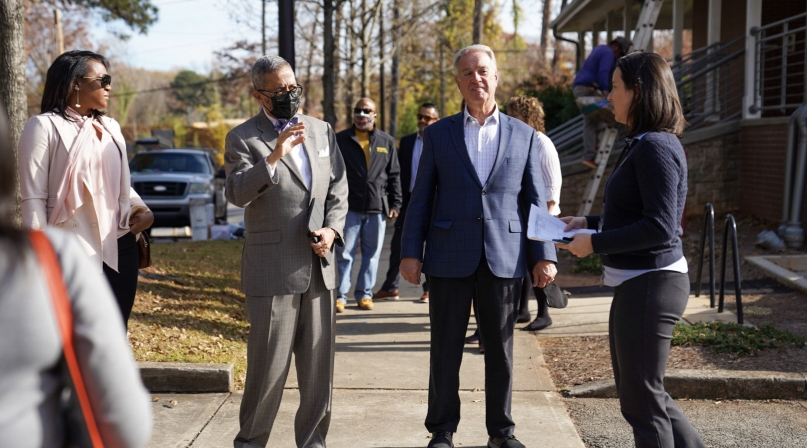
Key Takeaways
More than 200 county officials from across the country gathered Dec. 1–4 in DeKalb County, Ga. for NACo’s Large Urban County Caucus (LUCC) meeting. County officials had the opportunity to speak with specialists, network with far-off communities and experience exemplary programs in DeKalb County that they might replicate back home.
NACo President Larry Johnson welcomed NACo members and guests Dec. 2, at the official kick-off.
“Our goal is to make sure our counties are well-equipped and able to handle anything that comes your way, we just want to give you some extra tools,” said Johnson, a DeKalb County commissioner.
County officials heard from experts on infant mortality and prenatal care, DEI efforts, homelessness and American Rescue Plan Act funding.
“We’re pleased to see you all in person after the dark days of the pandemic,” said John O’Grady, LUCC chair and Franklin County, Ohio commissioner.
Fortifying foster care
The day before, county officials visited a counseling center campus for foster children in DeKalb County. the center, called CHRIS 180, welcomes foster care and homeless children in a program that strives to treat the whole person to help them integrate themselves into society.
“It’s a lot of work that we do to try to uplift people in the community” said Kathy Colbenson, president of CHRIS 180.
As more children in need come to the organization, CHRIS 180 has sought to provide solutions to their problems over their 40 years of service. After raising funds to build a 7-acre campus that includes housing, CHRIS 180 added a food pantry, health clinic, counseling and more, all to improve how well they can serve the community through trauma-informed counseling.
The center, said Colbenson, a therapist, is “not about toxic charity. We treat people with dignity. Trauma-informed care should not be about ‘What’s wrong with you?’ but ‘What happened to you?’” After the briefing, county officials broke up into groups led by CHRIS 180 employees to tour the campus.
She also discussed the nuts and bolts of creating the multimillion-dollar campus. Part of the equation included the use of the New Market Tax Credit. “It was an unbelievable amount of work and red tape, but worth it.”
New Black Wall Street Market
After the tour, county officials headed to a shopping center that helps Black entrepreneurs launch businesses. A former Target store, the center is an extension of the Allen Entrepreneurial Institute, created by philanthropist Bill Allen, who discussed his vision with county officials.
The shopping center was renovated in 10 months and includes more than 100 tenants. It is filled with minority entrepreneurs selling everything from original artwork to hand-rolled cigars to ginger-infused smoothies.
“Bill Allen wanted to see more minorities become successful entrepreneurs,” said Matt Hampton, director of the market.
“Most young people are not excited about a job,” Allen said. “They want to own their own business. ‘Ownership, ownership, ownership.’”
Infant mortality
During the Dec. 2 General Session, county officials learned from medical experts and frontline organizations about the ways communities can lower the infant mortality rate.
“In 2018, in my county, two to three babies a week died before the age of 1,” O’Grady said. “Counties have a critical role to play in addressing this crucial issue.”
Dr. Wanda Barfield, director of Reproductive Health at the Centers for Disease Control and Prevention talked to LUCC members about the importance of improving the health of the mother to impact the health and safety of the child. Infant mortality rate comes from the number of deaths per 1000 live births before their first birthday. Dr. Toyosi Okurounmu of United Healthcare Children’s Foundation; Christine Sander, director, Infant Wellness Initiatives at Nationwide Children’s Hospital and Maureen Stapleton, executive director, CelebrateOne, Franklin County, Ohio, discussed their regional programs.
“There is a love and spirit of collaboration that is required in order to tackle and win this fight,” Stapleton said.
The infant mortality rate nationally is 5.6 percent, but when broken down by race, it is much worse, they noted in their panel discussion. Traditionally underserved minority populations have a much higher infant mortality rate, as high as 10.6 percent.
Organizations are working diligently to drop the level by studying trends in infant mortality rates. Doctors can better identify unsafe conditions and help prevent future deaths by using data collection. Groups like CelebrateOne started a mentorship program, pairing at-risk mothers with “mentor moms.” By reaching out to at-risk women, the programs can educate, provide medical assistance and help guide new mothers through the challenges of the first year and beyond.
Economics 101
County officials heard from a representative at the Brookings Institute Metropolitan Policy Program and a Financial Market Economist with Nationwide. Deputy Director of the Brookings Institute Alan Berube advised that it was important to invest American Rescue Plan (ARP) funding for long-term gain. Berube said he expects the pendulum will swing back the other way soon as federal dollars dry up.
“The spigot is going to get turned off very soon,” Berube said. He suggested counties invest in nonprofits that benefit the community and focus on organizations that will be able to assist counties long after the federal funding is spent. He also suggested communities discuss projects on a regional basis and attempt to collaborate in a “potluck” style where all can benefit.
Scott Murray of Nationwide discussed the remnants of the Great Recession as well as economic indicators he is seeing.
“Once we get these supply issues corrected, and we sort of create a right-sized economy for the demands out there, we shouldn’t see persistent inflation moving forward,” Murray said.
The job market will likely shift due to generations no longer being financially stuck in their homes, he noted, and many have the freedom to move and work from home from anywhere in the country. The coming “silver tsunami,” of older workers permanently leaving the workforce, is another factor in the job market, he said. In all, 1.5 million Americans left the workforce during the pandemic, he noted, which gives an opportunity for others to advance and learn new skills. Murray said counties should focus on what makes them great, to attract workers and keep residents while they work elsewhere through building better broadband infrastructure. “What makes your community special to your citizens?” Murray asked. “How can we enhance that?”
Experts talk equity
Diversity, equity and inclusion (DEI) was a hot topic, in a panel discussion moderated by Hennepin County, Minn. commissioner and LUCC Vice Chair Angela Conley. Panelists discussed ways they are tackling DEI in their communities through healthcare, policy shifts, racial equity tools, budgets and data collection.
In Douglas County, Neb., where the Board of Health declared racism a public health crisis in 2020, Commissioner Christopher Rodgers noted that they have begun fighting against “your place determining your livelihood, determining how long you live.”
For the past several years, Rodgers has focused on tackling racial inequities in healthcare to better support the livelihood of underserved communities. In May 2020, the “shot heard round the world,” the death of George Floyd, opened a policy window that the county has been using to combat racial inequity, he said.
Efran Garcia, a diversity and inclusion officer in the Salt Lake County Mayor Jenny Wilson’s office in Utah, said the county has been able to draft actionable accountability metrics for the first time in 10 years after the murder of Floyd shined a spotlight on DEI practices across the country.
“In some cases, a single word can impact who’s able to receive or be declined from any of the services [of the county],” Garcia said.
The policy experts focused on improving their community’s acceptance of diverse people and the inclusion of those people in policy decisions. Through their efforts, they have educated county officials on how policies can negatively impact some groups more than others and how to work on fixing those shortcomings for a healthier community.
“I can’t express how important it is to be crafting and creating something as important as justice and equity with the actual community that you’re going to be serving,” Conley said.
Urban farming
Bobby Wilson saw a need for quality food and green space in low-income areas of metro Atlanta, so he created it. As the former program director for the University of Georgia Cooperative Extension/Atlanta Urban Gardening Program, Wilson formed the Metro Atlanta Urban Farm after he retired. The goal: To grow food and educate the community.
Wilson hosted LUCC officials and NACo board members, bringing them together to meet the many organizations he has partnered with to create a sprawling network of opportunity in urban farming.
“Our hope is that we here at Metro Atlanta Urban Farm will create some ideas that you can take back to your communities to help improve the quality of life by making sure we are maintaining and sustaining our green space in our inner cities,” he said, addressing county officials from the back of his pickup truck, with the sound of the farm’s clucking chickens in the background.
The Urban Farm is not only for farming initiatives, although there are plenty on their 5 acres. The Urban Farm partners with other groups to create gardens, rehabilitate green space and teach the importance of “sustainable high quality, low-cost” agriculture. During the event, members of the U.S. Department of Agriculture, local universities, community organizations and entrepreneurs showed off their products and techniques that county officials might replicate at home. County officials learned about specific ways to grow different crops, saw examples of urban gardens, walked through a mobile tour on farming equipment and drones.
Caution, not panic
The outbreak of the COVID-19 pandemic has revealed a sore lack of preparation for catastrophic-level events that “completely disrupt our way of life,” said Christine Kosmos, CDC director of the Division of State and Local Readiness.
The CDC has been working since the early 2000s to help counties prepare for any sort of health emergencies and that will continue moving forward, she said. To better support communities, the CDC has put senior-level specialists on the ground to in 27 states to help state and local organizations.
“By the end of next year,” Kosmos said there will be a senior-level epidemiologist “in every jurisdiction, every directly funded city, every territory” which will go a long way toward ensuring access to valuable information.
Eduardo Cisneros, COVID-19 Intergovernmental Affairs director, told NACo members he is feeling “optimistic” about how the US is tackling the pandemic and the emerging COVID variant Omicron. “We can’t predict the future, but we can prepare for it.”
Clarion call
After the pandemic, “it is not what is lost, it is what is left,” Penny Brown Reynolds, a ground-breaking former judge and lawyer who served as an inspiring keynote speaker during a luncheon on Dec. 3. “It is unprecedented time to be in public service considering the many challenges our nation faces and our communities face...Citizens are looking to you local leaders to deliver because they believe in you,” she told county officials.
A lawyer, pastor, county official, district attorney and more, Reynolds encouraged a “forward-thinking strategy” to support counties across the country that have seen nearly 800,000 deaths due to the pandemic. Echoing the THRIVE (technology, health, readiness, infrastructure, vulnerable populations, economic opportunities) message of NACo President Larry Johnson, Reynolds encouraged local leaders to consider how they might rebuild their communities.
“We should use this time to consider which parts of normal are worth rushing back to,” she said.
To that end, Reynolds encourages strong leadership. “What’s left is a need for leaders with integrity. Character matters, integrity matters…We are not suffering from a lack of resources,” she said. “We have been suffering from a lack of imagination.” Her message is clear: Work hard and collaborate across the aisle to better support the community, she said. “Collaboration is key.”
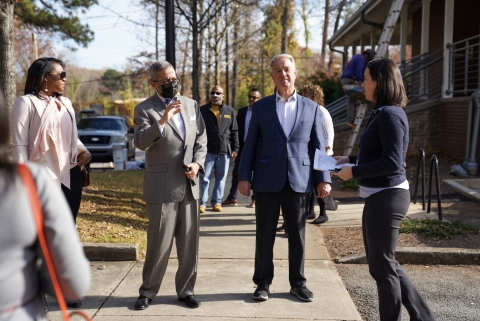
Attachments
Related News
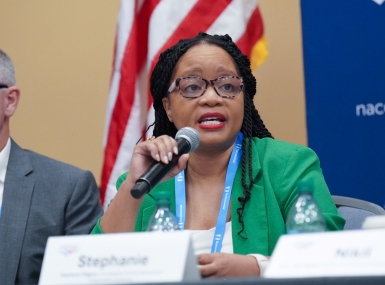
LUCC members discuss importance of urban transit
Following low ridership during and after the COVID-19 pandemic, investing in urban county transit systems is essential, now more than ever, to cultivate thriving communities, LUCC members said.
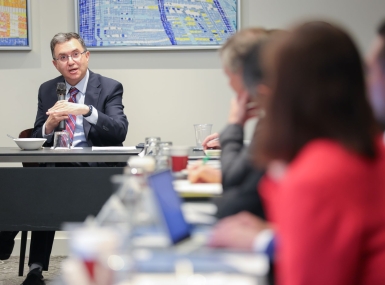
Ongoing support is crucial for counties tackling overdose rates
The best treatment option for polysubstance use is “contingency management,” which is when someone with substance use disorder is given an incentive, such as money, for not using.
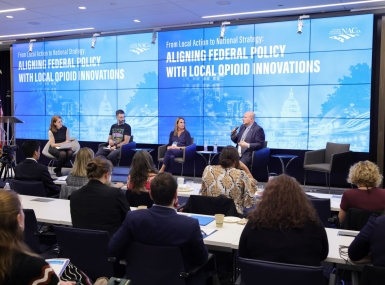
Proposed federal mandates cloud opioid treatment
Counties are positioned to quickly feel the effects of Office of National Drug Control Policy’s new priorities.